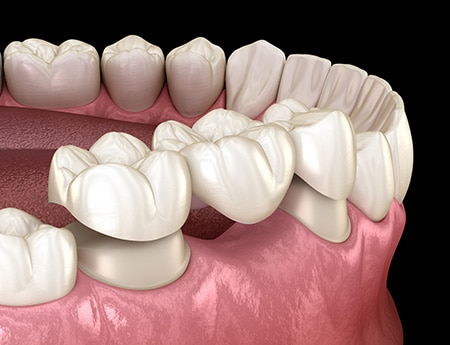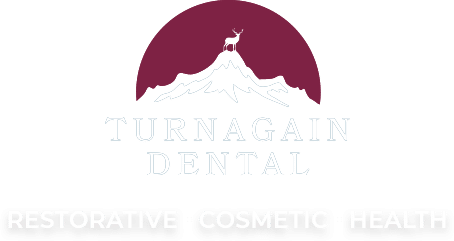 Ready to get a dental bridge in Anchorage? Dental bridges, which consist of one or more replacement teeth that fill the gap left by one or more missing teeth, do much more than improve the appearance of a smile. They restore a proper bite and normal chewing and speaking function. Bridges also preserve the surrounding teeth and prevent them from shifting around in the mouth, which can lead to serious complications.
Ready to get a dental bridge in Anchorage? Dental bridges, which consist of one or more replacement teeth that fill the gap left by one or more missing teeth, do much more than improve the appearance of a smile. They restore a proper bite and normal chewing and speaking function. Bridges also preserve the surrounding teeth and prevent them from shifting around in the mouth, which can lead to serious complications.
You have several choices in dental bridges, and Dr. Kennedy of Turnagain Dental can guide you to select the best fit for your personal dental needs. Book a consultation with the trusted restorative dentist to explore your options and find the most suitable solution.
Types of Dental Bridges
A traditional dental bridge consists of two dental crowns affixed to an artificial tooth (sometimes referred to as a pontic). The pontic fits into the space left by the missing tooth and the crowns are mounted to the teeth on either side of the space. To place a traditional bridge, Dr. Kennedy must slightly modify the shape of the adjacent teeth to accommodate the crowns.
Nowadays, it is becoming more common to support dental bridges with implants. Implant-supported bridges can replace more than one tooth without relying on the surrounding teeth for support. The two crowns on either end of the bridge are attached to dental implant posts and support one or more artificial teeth in the middle. An added benefit of implant-supported bridges is that the implant posts stimulate the underlying jawbone to prevent it from deteriorating due to lack of use.
Another type of dental bridge is a cantilever bridge, in which only one natural tooth is crowned. This crown typically supports two artificial teeth. Cantilever bridges aren’t as commonly used, but are a suitable solution for certain patients.
The third type of dental bridge is a Maryland bonded bridge. With this bridge, the artificial tooth has two small wings, or clasps, that attach to the backs of the teeth on either side of the gap. The backs of the teeth are slightly etched so the clasps can better adhere. These clasps can be crafted from either metal or resin materials.
Placing a Dental Bridge
 The placement process largely depends on the type of bridge.
The placement process largely depends on the type of bridge.
With a traditional bridge, Dr. Kennedy must first remove a small bit of tooth structure from the teeth adjacent to the gap. Once these teeth have been modified, impressions will be made for the design and construction of the crown.
Dr. Kennedy can place a temporary bridge over the area while the permanent bridge is being fabricated. This preserves normal dental function and protects the reshaped teeth.
Once the permanent bridge is ready, Dr. Kennedy removes the provisional restoration and places the bridge in the mouth. He checks its fit and the bite and can make any last-minute modifications if needed. Finally, Dr. Kennedy cements the bridge into place and polishes it.
When properly cared for, dental bridges can last a very long time. Dr. Kennedy provides detailed instructions for at-home oral hygiene and returning to his office for check-ups.
Advantages of Dental Bridge
Missing teeth leave gaps in your smile that affect function. Dental bridges are an excellent option if one to four teeth in a row are missing and include a host of benefits:
- Natural-looking tooth loss treatment
- Restored smile
- Restored chewing and speaking function
- Reduce the chance of nearby teeth shifting into the missing teeth gaps
- Feel similar to natural teeth
Dental Bridge Recovery and Care
 Recovery from a dental bridge procedure depends on the patient. This is because every patient’s procedure is customized to their needs. Generally, it takes a couple of weeks for the gums to heal. It may take a while to get used to your new bridge; however, you can expect a comfortable, secure fit that improves the function of your smile. Dr. Kennedy will provide aftercare instructions that detail how to take care of your smile following your dental bridge recovery to encourage quick healing. It is important to follow this plan, paying special attention to restricted activities and foods to avoid as you heal.
Recovery from a dental bridge procedure depends on the patient. This is because every patient’s procedure is customized to their needs. Generally, it takes a couple of weeks for the gums to heal. It may take a while to get used to your new bridge; however, you can expect a comfortable, secure fit that improves the function of your smile. Dr. Kennedy will provide aftercare instructions that detail how to take care of your smile following your dental bridge recovery to encourage quick healing. It is important to follow this plan, paying special attention to restricted activities and foods to avoid as you heal.
Taking care of your teeth after a bridge procedure is essential to oral health. If you do not already have a dental routine, this time is a great opportunity to create healthy habits.
Consider the following when caring for your new dental bridge:
- Brush twice daily using a toothbrush with the appropriate hardness. Dr. Kennedy can recommend options if you are unsure where to start.
- Floss daily to remove leftover food debris.
- Use nonabrasive toothpaste. Ensure that your toothpaste contains fluoride, which reinforces the teeth and encourages oral health.
- Pay special attention to the area under your dental bridge. Clean beneath the bridge daily using interproximal brushes, which are small brushes designed to clean between the teeth. Floss threaders may also be used to thoroughly clean this area.
- Avoid foods that are extremely hard or chewy.
- Avoid biting your fingernails or chewing on pens or ice.
- Visit Dr. Kennedy regularly for your dental checkups.
Dental Bridge vs Dental Implant
Dental implant surgery involves replacing the natural tooth’s root with a metal, screw-like post and replacing the missing tooth with an artificial crown. Dental implants can be used when bridgework or other restorative options are not the patient’s preferred option. Typically, dental implants may be performed if the patient has:
- One or more missing teeth
- Enough bone to secure the implant
- Healthy oral tissue
A major difference between implants and bridges is that implants replace the tooth and its root. On the other hand, bridges are made up of artificial teeth with crowns on either side that fit over natural teeth.
Losing teeth can be distressing, but there are a number of teeth replacement options available to you at Turnagain Dental. Because there is more than one restorative treatment for missing teeth, it can be hard to figure out which solution is right for you. Dr. Kennedy will evaluate your unique circumstances and craft a treatment plan that addresses your cosmetic and functional concerns related to tooth loss.
Book a Consultation to Discuss Bridges
If you are bothered by a noticeable gap left by a missing tooth or teeth, dental bridges can help. Request an appointment with Dr. Kennedy to discuss your bridge options today.
